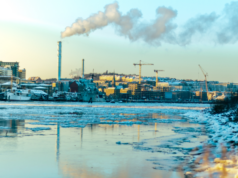While 71% of the Earth’s surface is covered with water, that doesn’t imply that all of it is drinkable. Only 3% of this volume is fresh water fit for drinking purposes. The water usage as a whole accounts for domestic, industrial, and agricultural purposes (see figure 1). The use of water is increasing every year in alignment with the population growth so as to meet the requirements of billions of people. This situation calls for a thorough understanding of the water usability. While many traditional methods of water usage continue to be implemented today, new and sustainable methods are emerging worldwide. This paper will assess the multitude of traditional and sustainable water usage methods as well as the advantages and disadvantages they impose on economic, environmental, political, and social factors.

Figure 1 World water usage statistics
Traditional water usage methods have been used worldwide for a wide range of purposes which broadly include domestic, agricultural, and industrial, each having their own positive and negative economic, environmental, political, and social implications. The way water has been utilized for these purposes has a significant impact on its retention and conservation status for use in the future. This gives rise to the need to assess these implications. Certain regions in the world experience water shortages while in other regions water is available in surplus quantities. The failure of political bodies in different regions of the world to equally provide water to all people has had significant social impacts. For example, in countries such as India where many people are dependent upon underground aquifers for water supply, poor water management has lead to contamination. Depleted underground aquifers are increased in depth to access more water (see figure 2). As the aquifers reach greater depth, it causes granitic rock to release fluoride into the groundwater. Fluoride poisoning has contributed to higher than normal cases of severe health issues such as arthritis and cancer. Although some groundwater is susceptible to pollution, underground aquifers which lie between impermeable layers of rock are immune to pollution. While the political stakeholders ensure that they will work to improve the traditional ways of water usage, the implementation of such commitments is not observed in most of the cases where pollution continues to occur in surface and groundwater supplies.

Figure 2 Diagram illustrating aquifer systems
A traditional method of water usage in the agriculture industry has been to irrigate crops using sprinklers. An advantage to this approach is the ability for farmers to water their crops in areas with inadequate rainfall. However, this method of crop irrigation is ineffective due to several factors including high evaporation rates and because the water does not reach its intended target. Another traditional method that has been used for the past couple centuries is the hydro dam (see figure 3). The advantages of the hydro dam include the fact it prevents flooding, is cost friendly, and is a renewable electricity source. Disadvantages of hydro dams include the blockage of fertile silt carried with floods, interruption in fish movement, and reduction in fish supply. Nonetheless, proper architectural design can help overcome the challenges presented with water usage via hydro dams.

Figure 3 Hydro Dam in Arkansas
Consequently, the aforementioned information helps make evident that the major resource management point of view associated with traditional methods is concerned with maximizing the benefits people can achieve from water usage. Water resource management refers to the planning and execution of such strategies that would ultimately lead to the optimal utilization of water. To develop a long-term framework for the management of water as a scarce resource, there is a need to facilitate not only careful utilization but sustainable conservation as well. In conclusion, it is important to develop such water resource management plans for household, agricultural, and industrial levels that will ensure water sustainability.
As the significance of traditional water usage methods is established, new emerging water usage methods ensure sustainability and carry with them economic, environmental, political, and social advantages and disadvantages. Close to 70% of the world’s fresh water is currently used in agriculture for irrigation purposes (see figure 1). As mentioned earlier, traditional crop irrigation methods such as sprinklers have disadvantages. A more sustainable method to replace the traditional method of sprinkler irrigation is drip irrigation (see figure 4). Drip irrigation involves perforated tubes which supply steady droplets of water to plants. The advantages to drip irrigation include better accuracy, less fresh water consumption, and less salt build up in the soil which helps with water retention. Using less water through drip irrigation will also help farmers be more economical by reducing the financial costs of water consumption. As a result, the agriculture industry can make a significant difference in improving water sustainability because currently only 1 % of the irrigated lands in the world use drip irrigation methods.

Figure 4 Drip irrigation system
While the majority of water is utilized for agricultural purposes, there is a need for the industrial sector to make such protocols and use robust technology that will support reusage of this water in some way rather than discarding it. For example, water that is used for cooling purposes such as for air conditioning can be continuously recycled. If this method is increasingly implemented, it can prove to be a huge step towards optimal water retention and consumption. Although domestic water usage is merely around 1-2%, still it is better to pay attention towards using such technology and products that facilitate minimal water usage. For instance, installing water efficient aerators and showerheads can reduce water consumption. While this method is sustainable, a disadvantage it may present to people is the associated financial cost. The protocols to save water, particularly in the agricultural and industrial sectors must be efficiently managed by political systems at the muncipial, provincial, and federal government levels to ensure nothing goes wrong. The state regulatory authorities should coordinate with the environmental sustainability authorities to come up with a plan. For example, in the 1990’s the cruise ship industry disposed of its sewage waste into open waters contaminating the water supply. The fines associated with improper disposal of sewage water were lower than what it would cost to dispose of the waste properly. Over time, new methods such as higher fines and satellite tracking were implemented by government bodies including the United States Coast Guard, which improved the cooperation between government organizations and the cruise ship industry in regards to the proper disposal of sewage waste. As sustainable water usage moves forward, the continued management of this valuable resource will require a robust outlook. Hence, the major resource management point of view regarding the aforementioned information is maintaining a sustainable water supply for indefinite use. In conclusion, sustainable water conservation has the potential to build a better future for the coming generations and indicates greater economic, environmental, political, and social advantages than disadvantages.
In the final analysis, both traditional and new, sustainable methods have many advantages in regards to their water usage and resource management viewpoints. However, new sustainable methods of water usage lack the number of economic, environmental, political, and social disadvantages in comparison to traditional methods. As a result, it is important to continue to identify and assess different water resource management views to improve sustainability for traditional methods while exploring and implementing newer ones.
Works Cited
Sovio, Henry P. Geography 12. 3rd ed. .: Green Heron Publishing, 2008. Print.
Maehlum, Mathias. Energy Informative. N.p., 5 May 2013. Web. 9 June 2016. <http://energyinformative.org/the-history-of-hydroelectric-power/>.
Digital image. Earth Online Media. N.p., n.d. Web. <http://www.earthonlinemedia.com/ebooks/tpe_3e/hydrosphere/aquifer_USGS.gif>.
Digital image. Ozarker.org. N.p., May 2013. Web. 7 June 2016. <http://ozarker.org/wp-content/uploads/2013/05/Bull_Shoals_Dam_aerial_photo-624×414.jpg>.
Digital image. Wikipedia. Wikimedia Foundation, 22 Nov. 2015. Web. 6 June 2016. <https://en.wikipedia.org/wiki/File:Pot_irrigation_by_On-line_drippers.JPG>.






